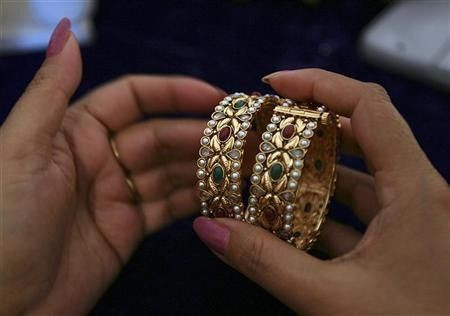India's Gold Demand Drops Below China Q4

Wild price swings caused by a volatile rupee sapped Indian buying interest in gold in the fourth quarter of 2011, with imports well short of expectations and no pick up expected this year, dropping it behind China for the first time.
Gold
India's gold imports in the last quarter of 2011, traditionally peak consumption season, fell 44 percent to 157 tonnes, although total imports last year rose 1.1 percent to a record high of 969 tonnes, the World Gold Council said on Thursday.
Indians are usually the biggest buyers of gold in the world and from October to December, the calendar is full of festivals and weddings, creating many opportunities for people to flaunt their finery.
But the country's fourth-quarter imports figure came short of a previous forecast of more than 281 tonnes.
China's gold consumption stood at a higher 190.9 tonnes between October and December, compared to 173 tonnes in India during the same period.
The rapid rise and fall in the rupee, and resulting domestic gold price swings had a strong impact on gold buying with both jewellery and investment demand in H2 lower by around 33 percent, the WGC said in a quarterly research report.
Gold prices rallied for the most of last year as safe-haven demand surged on the euro zone crisis and U.S. debt ceiling negotiations, among other factors, to a record in September before correcting sharply in the last quarter of the year.
Prices in India touched record highs too.
The most-active gold contract on the Multi Commodity Exchange hit a record high of 29,516 rupees per 10 grams in mid-November, or about $1,813 an ounce. It traded at 28,162 rupees per 10 grams by 0927 GMT.
Spot gold peaked at $1,920.30 in early September, and was last quoted at $1,717.6 an ounce.
CHINA TO BECOME WORLD'S NO.1 GOLD CONSUMER IN 2012
India's imports are likely to stay flat this year and China may eclipse India as the world's biggest gold consumer on an annual basis as well, the WGC said.
Gold demand (in India) in 2012 is likely to remain steady. There are many things that influence demand. Right now, I don't see a big change in demand, Ajay Mitra, managing director of India and the Middle East at the World Gold Council, told reporters.
Factors including the fluctuation in the rupee, overseas gold prices and government policy will influence India's gold demand, he added.
The Indian currency had plunged nearly 16 percent last year to hit a record low of 54.30 and was the worst performing Asian unit against the dollar.
A smaller number of auspicious days for weddings in 2012 will temper gold jewellery demand to some degree, he added.
The average gold price in India in 2011 was 23,620 rupees per 10 grams, up 31 percent compared to the previous year, Mitra said.
Though prices are still hovering near record levels, Mitra thinks lofty prices are unlikely to dent demand in 2012.
Indians have faith in gold. If you see returns in rupee terms, for the past three year it is giving more than 20 percent return every year, said Mitra.
Though India's short-term demand outlook may look lacklustre, the country still has the potential for future growth in gold consumption, officials from the WGC said.
On India, I think near-term it may have peaked with a flat year in prospect of tonnage, but medium-term the India growth, wealth and urbanisation story is intact and we expect new highs in demand, Marcus Grubb, WGC managing director, investment, told Reuters in an interview.
It is just that China is growing faster, playing catch-up after having disregarded the market until recently.
Grubb expected China's overall gold demand to grow 20 percent in 2012, with a near 10 percent increase in jewellery consumption and 30 percent jump in demand for physical bars and coins.
© Copyright Thomson Reuters 2024. All rights reserved.





















